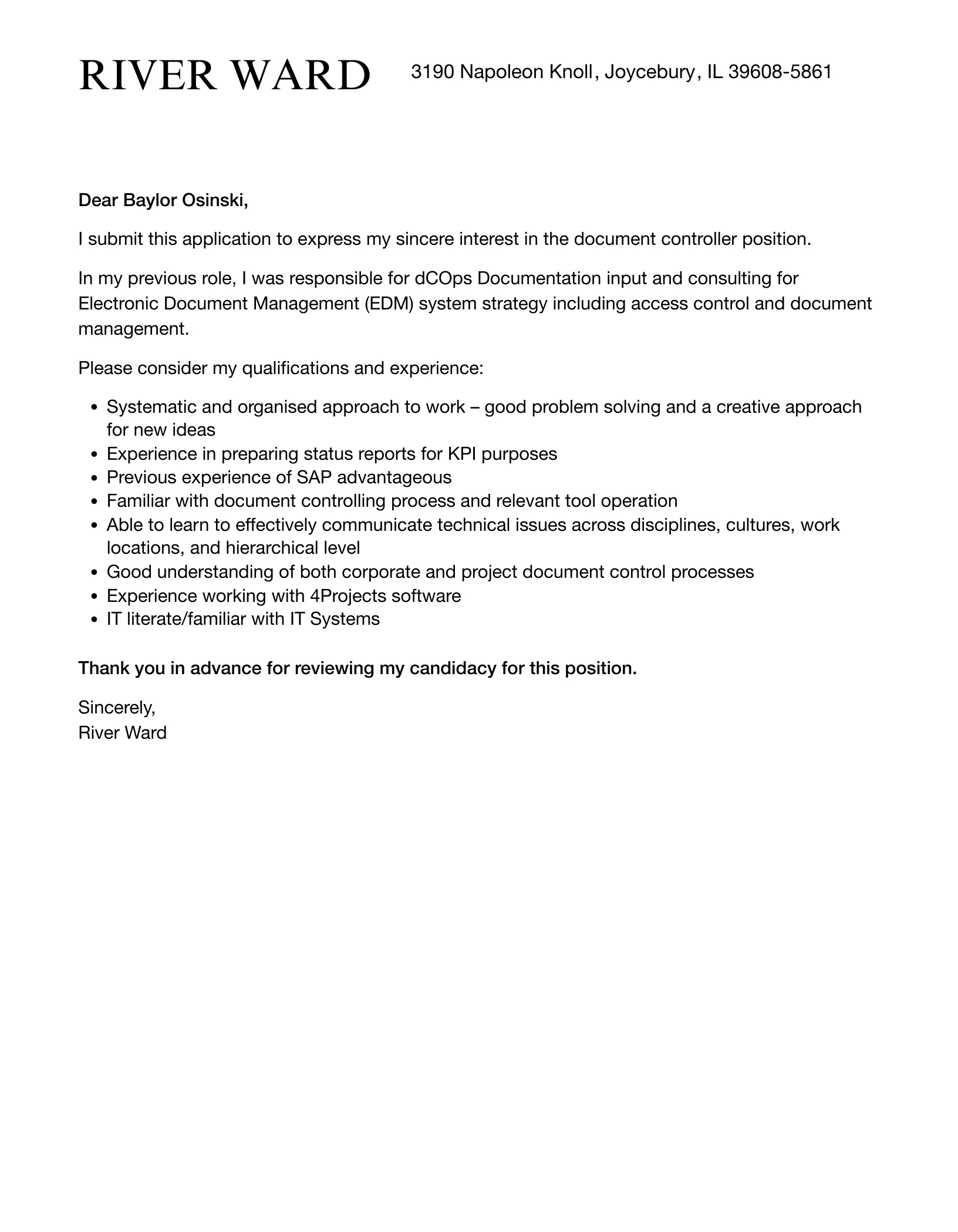Understanding the Importance of a Document Controller Cover Letter
A document controller cover letter is more than just a formality; it’s your first impression and a critical tool in securing your dream job. In a competitive job market, a well-crafted cover letter can be the deciding factor between getting an interview and being overlooked. It provides an opportunity to showcase your personality, passion, and relevant skills in a way that a resume alone cannot. A strong cover letter allows you to elaborate on your experiences, explain how your qualifications align with the specific job requirements, and demonstrate your understanding of the company’s needs. It’s your chance to stand out from the crowd and make a compelling case for why you’re the ideal candidate for the document controller position. Neglecting this important step could mean missing out on opportunities. Therefore, taking the time to create a customized and persuasive cover letter is an investment in your career.
Key Components of a Document Controller Cover Letter
A document controller cover letter should be structured to present your information clearly and persuasively. There are several key components that need to be included. Each part of the letter plays a specific role in demonstrating your suitability for the role. Ensuring that you incorporate these elements will significantly increase your chances of success in your application. From the initial greeting to the closing statement, every sentence should be carefully crafted to make a positive impact on the hiring manager. Let’s examine the necessary parts of the letter to see how to write the perfect cover letter.
Your Contact Information and Date
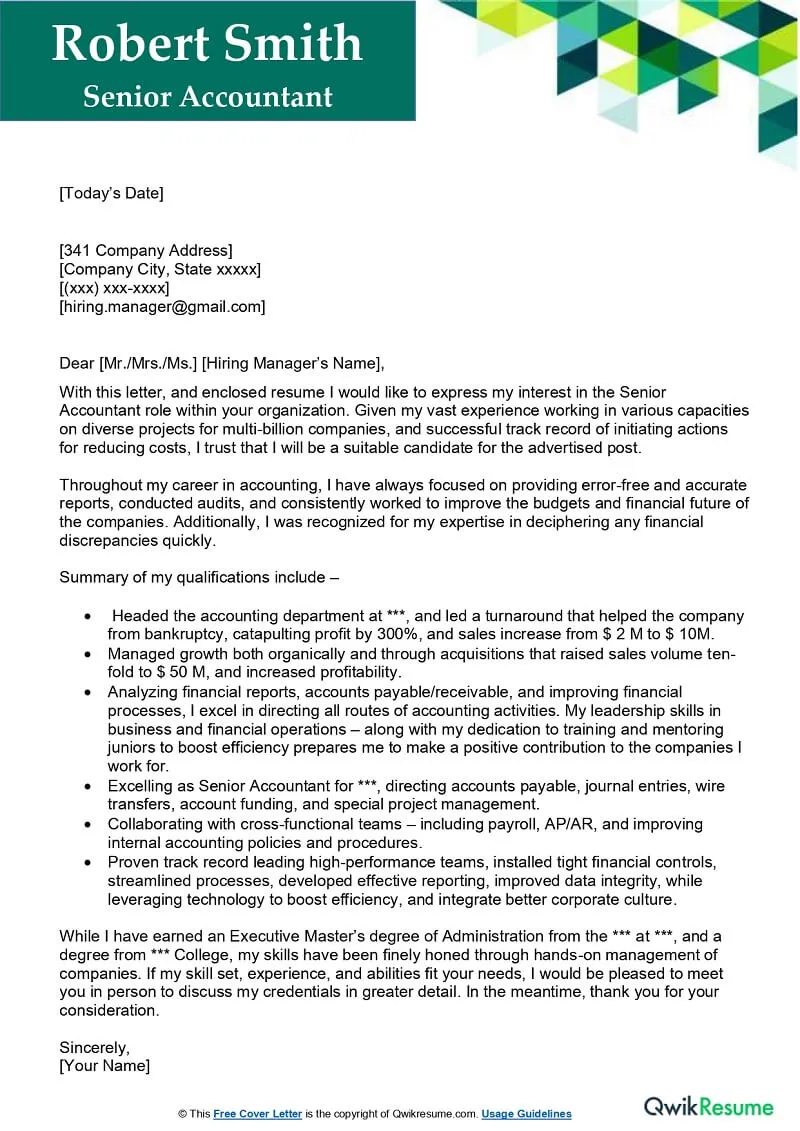
Start your cover letter with your full name, address, phone number, and email address. This information should be at the top left or right corner of the document. Following your contact information, include the date on which you are sending the letter. This ensures that the hiring manager knows when you applied, and they can easily reach out to you if they are interested in setting up an interview. The date should be formatted professionally and consistently throughout the document. Remember to keep your contact information current and professional so that the potential employer has multiple means to connect with you.
The Hiring Manager’s Information
Direct your cover letter to a specific person, if possible. Research the hiring manager’s name and title and include this information in the address section. If you’re unable to find a specific name, address the letter to ‘Hiring Manager’ or ‘Recruitment Team’ at the company. The effort to personalize the letter shows that you’ve taken the time to research the company and its hiring practices. This attention to detail demonstrates your interest in the role and your ability to follow instructions. Always double-check the accuracy of the name and title to show respect and professionalism.
A Strong Opening Statement
The opening paragraph of your cover letter sets the tone and captures the hiring manager’s attention. Begin by stating the position you are applying for and where you found the job posting. Briefly highlight your most relevant skills and experience that align with the job requirements. If you were referred, mention the name of the person who referred you to give the hiring manager immediate context for your application. Make sure your opening paragraph is concise, confident, and enthusiastic. It should immediately demonstrate your understanding of the role and why you are a suitable candidate. Your aim is to capture the reader’s attention and motivate them to read the rest of the letter.
Highlighting Relevant Skills and Experience
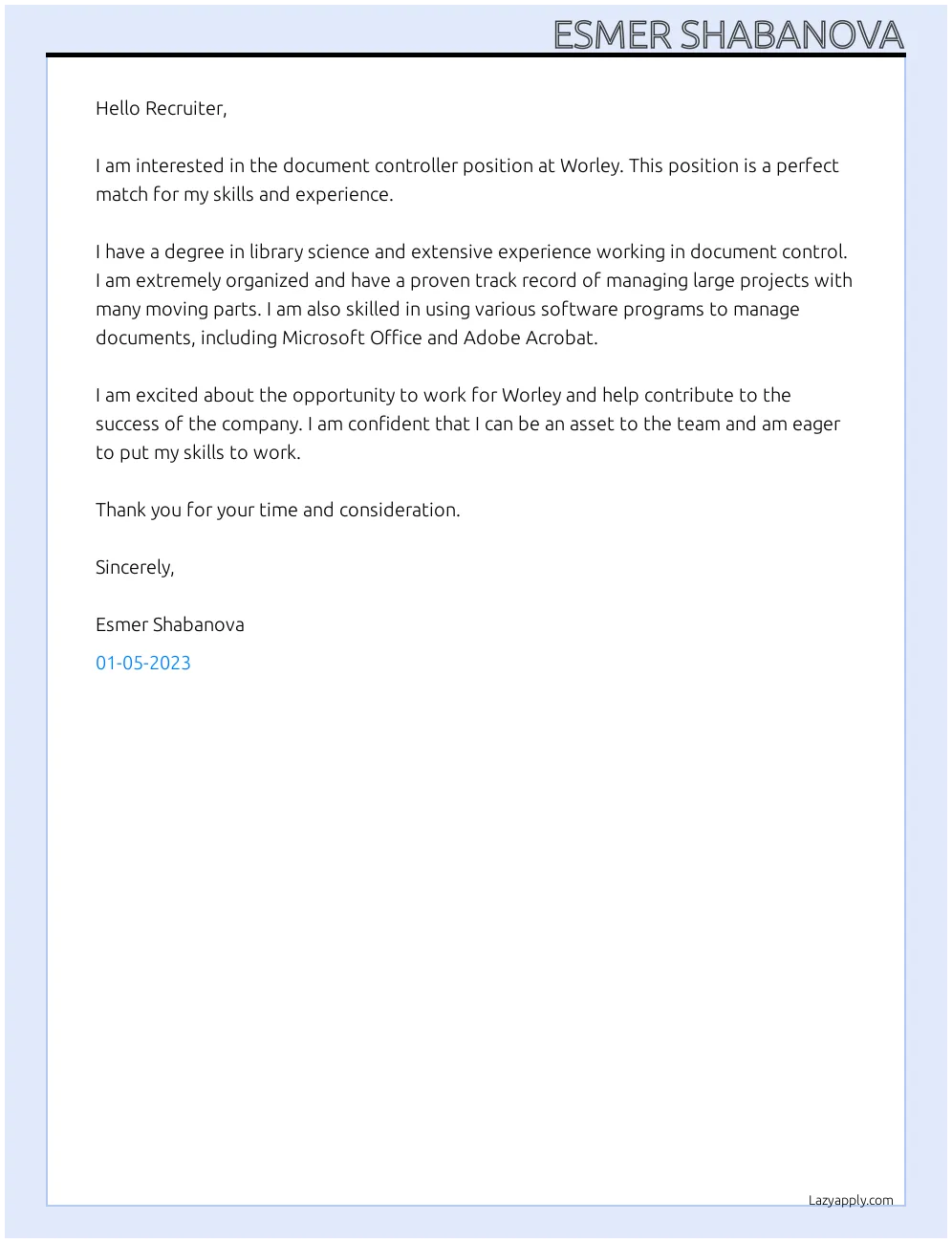
The main body of your cover letter should showcase your relevant skills and experience, demonstrating how they align with the job requirements. Use specific examples from your previous roles to illustrate your capabilities. Quantify your accomplishments whenever possible by using numbers, percentages, or other metrics to demonstrate the impact of your work. When describing your experiences, focus on the responsibilities and projects that are most relevant to the document controller role. Organize this section logically, highlighting your technical skills, attention to detail, organizational abilities, and any other key attributes listed in the job description. Each paragraph should clearly connect your past experiences to the current job opportunity.
Technical Proficiency
Document controllers should be proficient in document management systems (DMS). In your cover letter, mention your experience with specific software or systems, such as SharePoint, Documentum, or other relevant platforms. If you have experience with any industry-specific software, make sure to highlight it. Showcase your ability to manage and maintain document control processes, and ensure that documentation is organized, retrievable, and compliant with industry standards. Demonstrate how you have used these systems to streamline processes, improve efficiency, and ensure accurate record-keeping. Mention any training or certifications you have related to document management systems.
Attention to Detail and Accuracy
Attention to detail is a critical skill for document controllers. In your cover letter, provide examples of how you have ensured accuracy in your previous roles. Mention your experience reviewing documents for completeness, accuracy, and compliance. Showcase your ability to identify and correct errors, maintain version control, and manage document revisions. If you have experience with quality control or compliance procedures, be sure to mention this. The goal is to provide evidence of your ability to meticulously manage documents and maintain a high level of accuracy.
Organizational and Time Management Skills
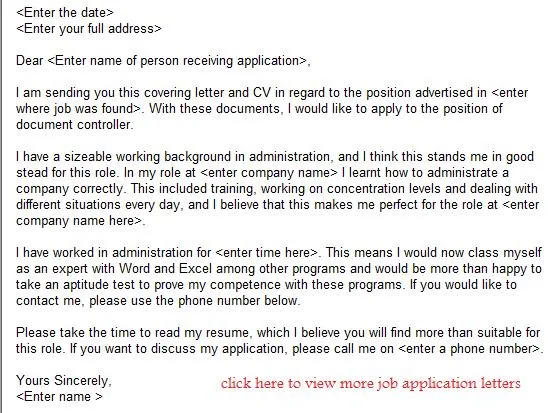
Demonstrate your organizational and time management skills. Document controllers must be able to manage large volumes of documents, prioritize tasks, and meet deadlines. Describe your experience with document filing systems, archiving processes, and the ability to organize information efficiently. Highlight any experience with project management or coordinating documentation efforts. Show your ability to manage multiple tasks simultaneously while maintaining accuracy and attention to detail. Showcase your experience in meeting deadlines and managing multiple projects efficiently. Include specific examples that demonstrate these abilities.
Tailoring Your Cover Letter to the Job Description
Customizing your cover letter to the specific job description is key to success. A generic cover letter will not make a strong impression. Read the job description carefully, and identify the key requirements and desired skills. Then, tailor your letter to address these requirements directly. Use the same keywords and phrases from the job description to show that you understand the needs of the role. Customize the examples you provide to reflect the specific duties and responsibilities mentioned in the job posting. This demonstrates that you have researched the role and are a good fit for the company. Showing this level of understanding and customization is crucial for capturing the hiring manager’s attention.
Researching the Company
Before you start writing your cover letter, research the company and its mission. Understanding the company’s values, projects, and industry position helps you tailor your application more effectively. Visit the company’s website, read news articles, and check their social media profiles. Look for information about their document management practices, the projects they’re involved in, and any specific challenges they face. This research will not only help you customize your cover letter but also enable you to demonstrate your genuine interest in the company. Showing a basic understanding of the company indicates your eagerness to learn more and fit within the company’s culture. Showing that you understand the company’s needs makes a better impression.
Matching Skills with Requirements
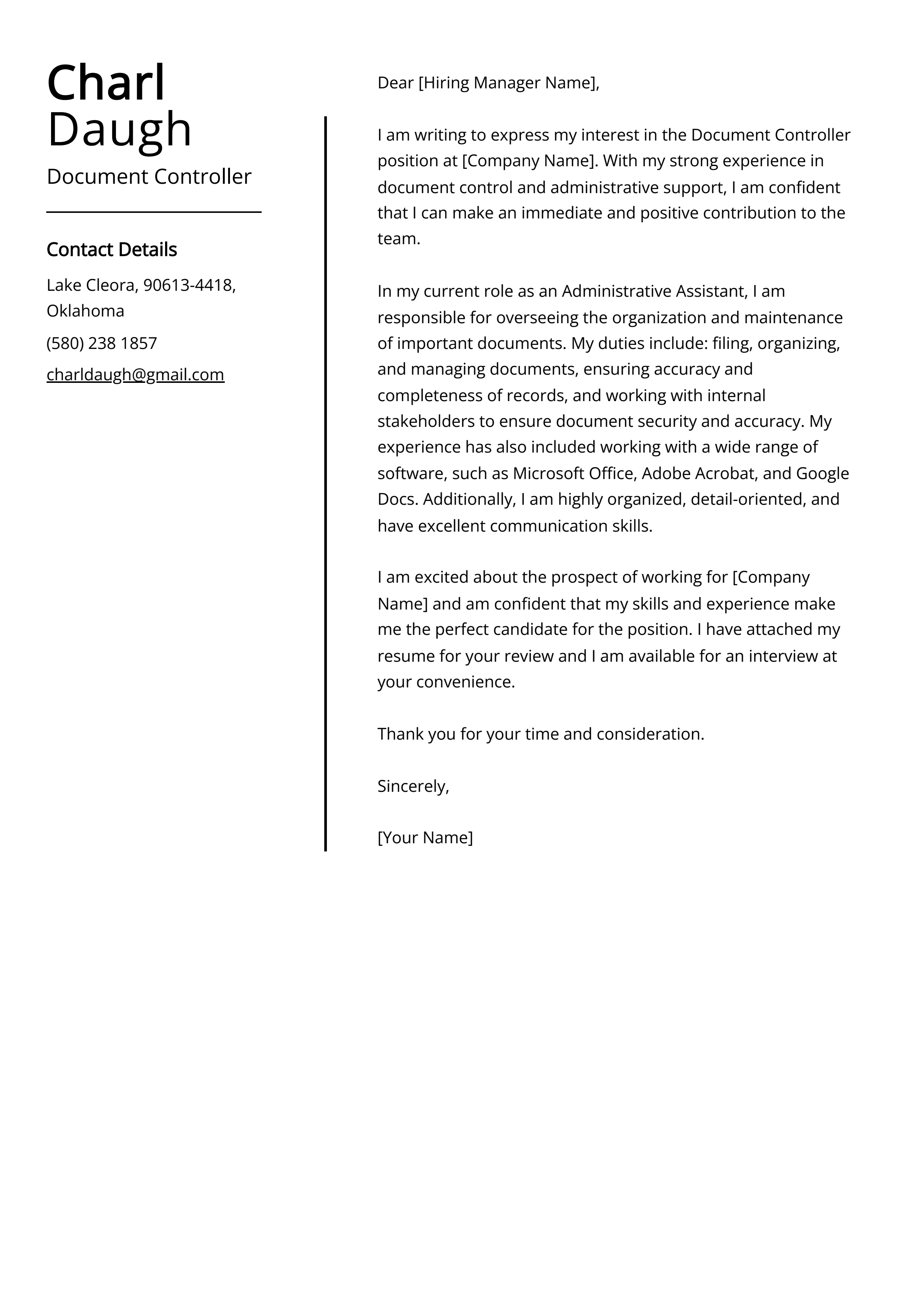
Identify the key skills and qualifications listed in the job description. Then, review your own skills and experiences, and match them to the requirements. Focus on the skills and experiences that are most relevant to the position. Use the job description to guide your language and content. Provide specific examples that illustrate how you have demonstrated these skills in your past roles. Explain how your experience aligns with the needs of the company and the job. This ensures that the hiring manager quickly recognizes that you have the necessary qualifications.
Using Keywords Effectively
Incorporate keywords from the job description throughout your cover letter. Use keywords to highlight your skills and experiences. When writing your cover letter, make sure you use the language of the job description. This is especially important if the company uses applicant tracking systems (ATS). These systems scan applications for keywords, and if your cover letter does not contain the right keywords, it may be automatically rejected. Integrate keywords naturally into your sentences. Make sure the keywords fit the flow and tone of your letter. Using the right keywords will improve your chances of getting noticed and advancing to the next stage of the hiring process.
Formatting and Presentation
The formatting and presentation of your document controller cover letter are as important as its content. The layout, tone, and organization of the document should be professional and easy to read. Ensure your cover letter is visually appealing, organized, and free from errors. Consider the overall impression that your cover letter makes, as it reflects your attention to detail. These details play a vital role in how hiring managers assess your suitability for the position, showcasing your professionalism and communication skills. Here’s what to keep in mind.
Professional Tone and Language
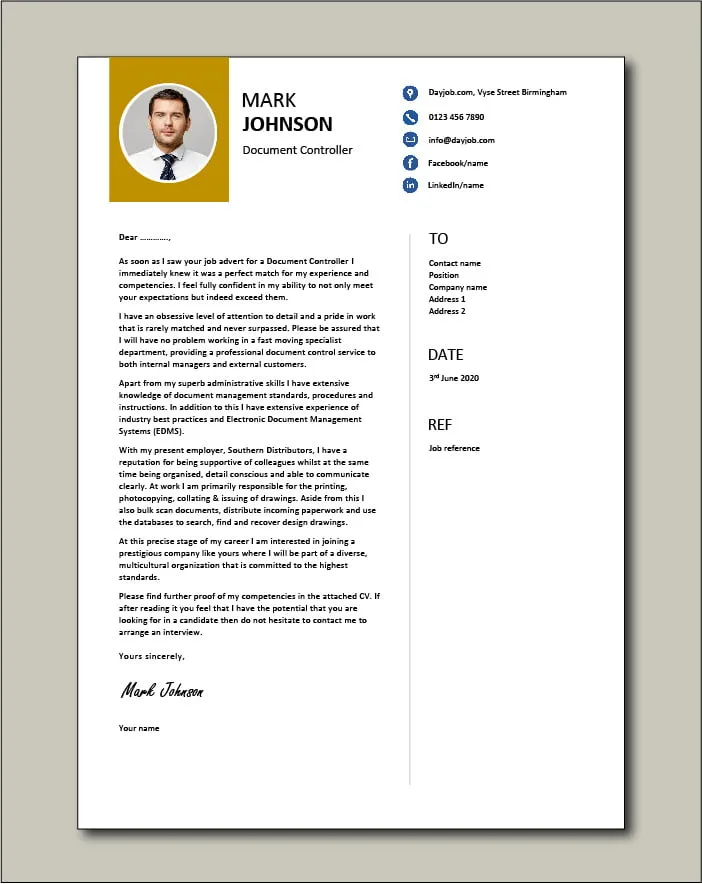
Maintain a professional tone and use clear, concise language. Avoid jargon or overly complex sentences. Use positive and enthusiastic language. The tone should reflect your confidence and enthusiasm for the position. Write with a professional style. Proofread your cover letter for any grammatical errors. Ensure that your sentences are well-structured and that your ideas are presented logically. Make sure the language is consistent and professional. Show your writing ability in a professional and clear style.
Proofreading and Editing
Thoroughly proofread your cover letter before submitting it. Check for any spelling errors, grammatical mistakes, or inconsistencies in formatting. Typos and errors can create a negative impression and detract from your qualifications. Read your cover letter aloud to catch any awkward phrasing or unclear sentences. Ask a friend or colleague to review your cover letter for feedback. A fresh pair of eyes can often spot errors that you might have missed. Make sure that your cover letter is polished and error-free. The goal is to show you pay attention to detail.
Closing Your Cover Letter
The closing of your cover letter is an important part of the letter. It summarizes your interest in the role and provides an opportunity to reiterate your key qualifications. Express your enthusiasm for the position, and make sure to include a call to action that encourages the hiring manager to contact you for an interview. A strong conclusion will leave a lasting positive impression, encouraging the recruiter to reach out to you. The closing should be professional and persuasive.
Expressing Enthusiasm
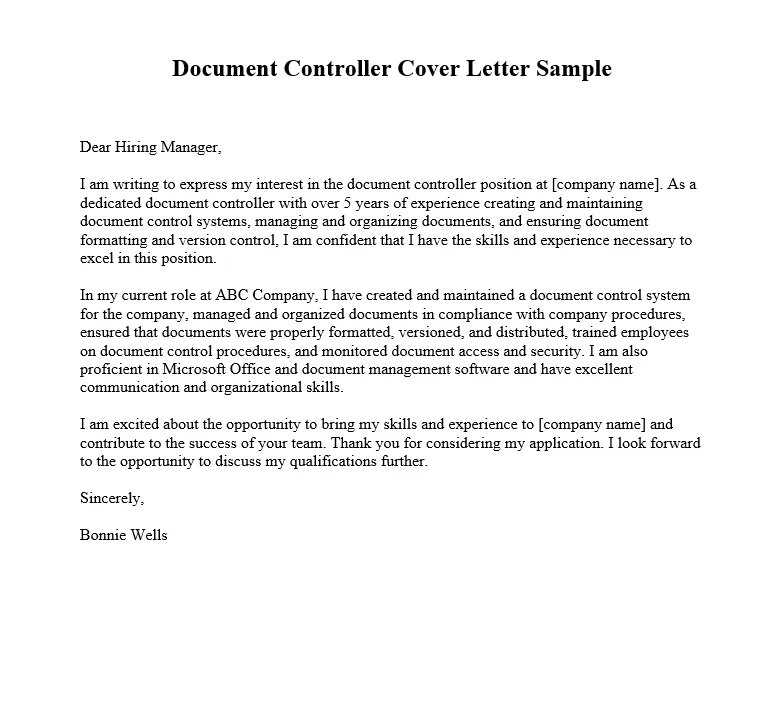
Express your genuine enthusiasm for the document controller position. Reiterate your interest in the company and its mission. Show how excited you are about the opportunity to contribute your skills and experience to the team. You should be confident and express your desire to be considered for an interview. Be sincere and passionate, and make sure your enthusiasm is reflected in your language. Demonstrating your enthusiasm helps to make a strong impression and increases your chances of getting hired.
Call to Action
Include a clear call to action, encouraging the hiring manager to contact you for an interview. Provide your contact information again. Express your availability for an interview, and thank the hiring manager for their time and consideration. Make it easy for them to take the next step. A clear call to action will make the process easier. This might involve expressing your willingness to provide additional information or to discuss your qualifications further.
Following Up After Submission
After submitting your cover letter and resume, it’s important to follow up with the hiring manager. A follow-up email can show your continued interest in the position. Send a brief thank-you email a week after submitting your application, restating your interest and mentioning a key skill or qualification. Remind them of your suitability for the role. Be sure to follow the company’s guidelines. You can also follow up with a phone call. This shows that you are proactive and serious about the opportunity. If you do not hear back after a reasonable amount of time, you can follow up again.
